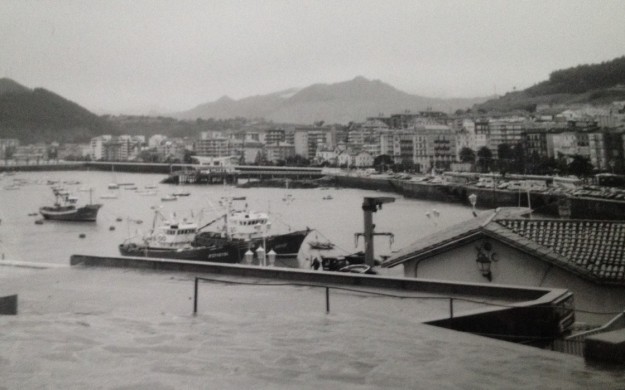What time is it? Who knows? Who cares?
Where am I? Middle of the bloody Bay of Biscay.
Where am I actually supposed to be? At home in a nice, quiet, motionless bed.
I am going to start this off with our Bilbao excursion; it has to rate as one of our less successful outings, but it was one of the first, and provided a useful phrase.
My husband, Peter, and I went on a free cruise from Portsmouth to Bilbao when our son and daughter were just old enough to be left with grandparents for the couple of days we needed to make an excursion doable. (I have no clear idea now why we had achieved a free cruise but I believe it had something to do with the purchase of a water-cooler for Peter’s business.)
A free cruise to Bilbao? We could see the Guggenheim. Admire some Frank Gehry architecture, take in a little Mark Rothko, contemplate the peotry (deliberate misspelling) of Lipchitz’s Working Model for Government of the People, or simply admire the minimalism of Jorge Oteiza’s Empty Box with Large Opening. We could follow that up with a little frittata and olives in a café in the Old Town… Worth buying a water-cooler for the Empty Box alone, I thought. Besides, the last time I had visited Spain, as a schoolgirl in 1974, the country was still under the rule of Franco. I was interested to see if the country felt democratically different.
About two hours after setting off, gazing at a black and churning channel, I was seriously contemplating swimming my way back to Portsmouth. I wasn’t sea-sick. (Many fellow passengers were and the scent of vomit covered several later proceedings.) I just disliked the perpetual motion and the rolling darkness. I also disliked the students who positioned themselves outside our cabin door and played the guitar very badly in the intervals when they were not actually divesting themselves of their dinner.
The highlight was arriving in Bilbao to see The Art. We stepped off the ship with a jaunty air — for one thing, we had survived 24 hours at sea and a stormy crossing of the Bay of Biscay (with guitars) — only to discover that on Mondays the Guggenheim was closed. We were scheduled to sail back to Portsmouth before the end of the day.
“We have journeyed for a night and a day across the Bay of bloody Biscay to see a closed art gallery?” I said.
“Looks like,” said Peter. “But we have a water cooler.”
In our defence, this was in the last millennium, before the quick Let-Me-Google-That-For-You fix for art-gallery opening times. Google itself was still in a garage in embryonic form at the time. These things happened.
As we couldn’t see any art, we joined an impromptu walking tour, assembled at the dock (this was before the shiny new passenger terminal, too) and off we set to see Bilbao in the rain. Our free cruise was, of course, in November, because no-one gives away free cruises, even for water-cooler purchases, at the height of the tourist season. The walk was memorable mainly for our enthusiastic tour-guide’s descriptions of how the citizens had salvaged the art treasures of their city during the Spanish civil war.
On 31 August 1936, Bilbao suffered its first bombing. The bombing of Guernica, 30 kilometres to the east, the spiritual capital of Basque people — now a haunting milestone as one of the first air raids on civilians — began on 26 April 1937 (also a Monday). Between these dates, the people of Bilbao prudently moved their religious artworks out of the town and into caves on the slopes of the wooded hillsides. Wisely, because as Franco’s forces gained power, churches were burned. Our guide was very precise with the details as she stood under the dripping beech trees, diverting from her native Basque into English. “She was a virgin in the church and then she was a virgin in the woods and this is very interesting because of this.”
Years later, Peter and I would still be saying to each other: “This is very interesting because of this.”
We ended the walk with a visit to a port-side bar. Our talos con chistorra (tortillas with sausage) and porrusalda (leek soup — although Leak Soup is actually what it said on the menu) in our small array of pintxos cheered us up a little.
We sailed home that night, Guggenheim-innocent, but impressed by the survival of Bilbao’s religious icons. There they were, the citizens of Bilbao, in the middle of a bloody civil war, hauling their Juan Pascual de Mena sculptures up hills, and their virgins to the woods.
The journey was 24 hours back, as well, and the Bay of Biscay was as dark and unfriendly as before. We had lost the students, which made sleeping easier, but gained a new appreciation of the art-loving efforts of the Basque people.

